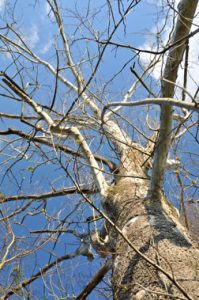Name That Tree
by Mary Farkosh Francis, Fairfax Master Gardener Intern
 If your answer was the American sycamore (Platanus occidentalis), you are correct. It is also called American planetree, buttonwood and buttonball tree. Native to 36 states, it is most commonly seen in the eastern U.S. along streams and bottomlands. American sycamore is hardy in Zones 4 to 9, adaptable to a wide variety of soils and is tolerant of air pollution and drought.
If your answer was the American sycamore (Platanus occidentalis), you are correct. It is also called American planetree, buttonwood and buttonball tree. Native to 36 states, it is most commonly seen in the eastern U.S. along streams and bottomlands. American sycamore is hardy in Zones 4 to 9, adaptable to a wide variety of soils and is tolerant of air pollution and drought.
This tree becomes massive with a single trunk, reaching a height of 75 to 100 feet or more, a width of 75 to 100 feet or more, and a diameter of 4 to 8 feet, with some records up to 16 feet. The branches are heavy, horizontal and crooked with a zigzag growth pattern forming a rounded, open crown.
The most notable ornamental feature of this huge tree is its readily exfoliating bark often described as “camouflage” bark. The bark exfoliates in irregular pieces leading to a mottled brown, green, tan and white pattern. It is a significant winter feature.
 The leaves are very large, measuring about 6 inches long and 4 to 10 inches wide. They are alternate, simple, medium to dark green, with three to five lobes palmately veined. The leaf margins have coarse teeth. The petioles flare out to enclose the buds. The overall shape resembles a large sugar maple (Acer saccharum) leaf. Young leaves in the spring have fine, short hairs (pubescent) on both the upper and lower surfaces. By summer, only the lower leaf veins are pubescent. The leaves often flutter in the breeze. Fall color is an unattractive brown or tan.
The leaves are very large, measuring about 6 inches long and 4 to 10 inches wide. They are alternate, simple, medium to dark green, with three to five lobes palmately veined. The leaf margins have coarse teeth. The petioles flare out to enclose the buds. The overall shape resembles a large sugar maple (Acer saccharum) leaf. Young leaves in the spring have fine, short hairs (pubescent) on both the upper and lower surfaces. By summer, only the lower leaf veins are pubescent. The leaves often flutter in the breeze. Fall color is an unattractive brown or tan.
American sycamore flowers appear in March or April. The flowers are monoecious. Male flowers are yellow; female flowers are red. The flowers are insignificant and small, and appear in clusters, typically one cluster to a stalk.

Sycamore flower
Sycamore is valuable as a timber tree. Its wood is hard with a twisted, coarse grain. Wild birds eat the seeds, including purple finches, goldfinches, chickadees and dark-eyed juncos. Larger trees provide nesting habitat for birds, including wood ducks.
The American sycamore is susceptible to anthracnose. Verticillium wilt, canker stain, powdery mildew, leaf scorch and sycamore lace bugs can also be problematic. When grown as a lawn tree, the large leaves, exfoliated bark, fruiting balls and twig litter can be problematic. When American sycamore sheds the tiny hairs from its leaves and twigs, it may cause an allergic reaction.
This tree should never be planted in small spaces. The tree must be carefully sited to accommodate its massive mature size.
American sycamore is a superb large shade tree. It is useful as a specimen tree or focal point tree in large open areas. It provides bold texture, both in foliage and when bare. The bark and fruit provide winter interest.
References
American Sycamore (Platanus occidentalis), Nebraska Forest Service
Platanus occidentalis, Plants, North Carolina State University Extension
Platanus occidentalis, The Ohio State University
American Sycamore, Virginia Tech Dendrology Fact Sheet
Sycamore (Platanus occidentalis), Tree Identification, Iowa State University Forestry Extension